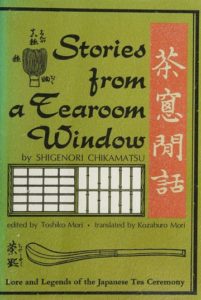 My policy is if it’s published by Tuttle, it’s usually a good book. Still, I’ve passed over this book a few times on the library shelf, because I mistook it as a historical collection of fictions. What this book really is, is a collection of recounted exchanges, anecdotes, and records of ownership of ‘mythical’ chanoyu utensils.
My policy is if it’s published by Tuttle, it’s usually a good book. Still, I’ve passed over this book a few times on the library shelf, because I mistook it as a historical collection of fictions. What this book really is, is a collection of recounted exchanges, anecdotes, and records of ownership of ‘mythical’ chanoyu utensils.
It’s a fairly short and easy read, so I’d say worth picking up. Alongside works like The Book of Tea, and Cha Jing, it doesn’t specifically have merit as a beginner’s guide; rather, it’s more for its historic merit, giving some insight into the history and cultural context of tea in Japan. Each anecdote is usually only a paragraph long, or at least less than a page. Many describe historic chanoyu implements, their provenance, and what might have happened to them. Some are short prose meant to convey the atmosphere of certain tea master’s tea rooms, or their attitudes, or specific quotes of wisdom attributed to them. Some of the anecdotes lead directly from one into another, often as sequels. One that comes to mind is a couplet exhibiting how two different tea enthusiasts treated their chagamas, showing how one was the superior tea master based on the respect he showed to his utensils.
The book is based on a much larger compilation, titled “Legends of the Tea Ceremony”, containing over 300 stories. This is a translation of the abridged edition (“Stories From a Tearoom Window”), containing only 129. The author of the original, Shigenori, was not himself a tea master, but a warrior with a keen interest in the art. So he sought to pen down every second-hand story, anecdote, or quote attributed to chanoyu in an attempt to collect the wisdom of the masters. This book is divided into two parts, the first containing stories 1-113, the second only stories 114-129. I’m not really sure the reason for the break, especially as the second half only has 15 verses that aren’t any longer than the others. It’s interspersed with beautiful hand-drawn pictures of various tea implements, houses, and persons, many pictures pulled from the original Japanese edition of the work, and many more from other well-known tea books, such as Sadler’s “Chanoyu”. The volume I checked out from the library is a handsome, block-printed hardback, that I think would appeal greatly to anyone just looking for pretty tea books to display on a shelf.
As for costs, this translation is in the public domain, so don’t get tricked into a kindle purchase. The PDF on archive.org is perfectly legible. This book is out of print, and seems to start at $40 on abebooks and amazon. It looks like the only editions made were hardcover, so finding a pretty edition of this book doesn’t look too difficult.




Leave a Reply
You must be logged in to post a comment.